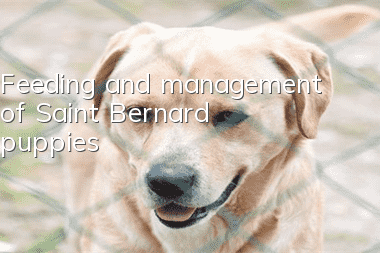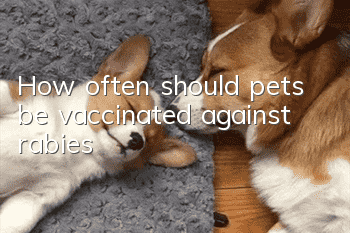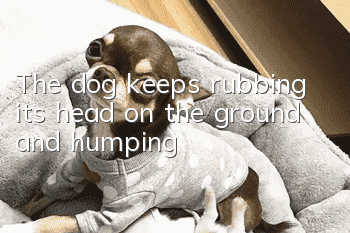Feeding and management of Saint Bernard puppies

The Saint Bernard is native to Switzerland and is a super-large dog in the world today. It is world-famous for snow rescue. The St. Bernard dog has a large head and wide nose, large and drooping ears, a straight and short nose bridge, sunken eye sockets, a thick and short neck, a wide and deep chest, a wide body and a long back, a tall and well-proportioned dog, well-muscled, thick limbs, and a long and drooping tail. The hair type is divided into two types: long and short: the long-haired type has thick and straight back hair; the short-haired type has short and shiny hair. The coat color is yellow with white markings or other color markings. How to raise and manage St. Bernard puppies?
Saint Bernard
Puppy feeding and management
Puppies refer to dogs from birth to weaning. Newborn puppies are deaf and blind. They can stand after 10 days, begin to open their eyes at 10-12 days, have hearing at 13-15 days, and can walk at 21 days. The characteristics of puppies during this period are: poor mobility, immature body temperature regulation and digestive functions, lack of innate immunity, poor disease resistance, but rapid growth and high nutritional requirements. The following issues should be paid attention to during the daily raising and management of puppies
1. Umbilical cord protection
The broken part of the puppy's umbilical cord usually dries after 24 hours and falls off in about 7 days. During this period, you should pay attention to the changes in the umbilical cord and do not let the puppies lick each other's umbilical cord area to prevent infection.
2. Eat enough colostrum
For newborn puppies, breast milk is their only source of nutrition. Breast milk within 3 days after delivery is called colostrum. There are no antibodies in the body of puppies, but colostrum contains a variety of antibodies. After the puppies eat colostrum, they can enhance their disease resistance. Colostrum is also rich in nutrients: vitamins A and D are 10 times and 3 times that of normal milk respectively, and are rich in protein, fat, and iron. The acidity of colostrum is high, which is beneficial to the digestive activities of puppies; its viscosity It is larger and can protect the gastrointestinal mucosa of puppies; it has high mineral content and has a laxative effect on puppies, which is beneficial to the discharge of meconium. Therefore, newborn puppies should eat enough colostrum as early as possible.
3. Fix the nipple
Puppies should have fixed nipples when feeding, otherwise there will be a phenomenon of snatching weak food, resulting in uneven growth and development of the puppies. For puppies that cannot eat breast milk, especially those that are thin, artificial assistance is needed to help them find and fix on the nipple with more milk.
4. Pay attention to heat preservation
Within 1 week of birth, puppies have sparse coat, less subcutaneous fat, and poor thermal insulation ability, so special attention should be paid to thermal insulation. The most suitable environmental temperature for newborn puppies is: 29-32℃ in the first week, 26-32℃ in the second week-29℃, 23--26℃ in the 3rd week, normal temperature is enough after the 4th week, but around 23℃ is appropriate. When giving birth in winter or early spring, heating facilities such as stoves, fire pits, and infrared lamps should be installed in the delivery room.
5. Stimulate defecation
Newborn puppies cannot pass feces on their own for more than 10 days after birth. Generally, when the puppies are suckling, the mother dog will lick the perineal area or lower abdomen to stimulate the discharge of urine and feces. However, if the female dog is not maternal and does not lick, the breeder should use cotton wool dipped in cold water or a warm wet towel to wipe the anus of the puppies 3-4 times every day, and give artificial stimulation to stimulate the puppies. The discharge of feces.
6. Proper exercise
Five days after the puppies are born, at noon when the weather is fine, the puppies and the mother dog can be taken outside the house to bask in the sun for about half an hour, so that the mother and baby can fully breathe fresh air. At the same time, ultraviolet rays can also be used to kill bacteria on the dog and promote The bones of puppies grow and develop and prevent the occurrence of rickets.
7. Protect your eyes
After the puppies are born, they can open their eyes as early as the 9th day, or as late as the 12th or 13th day. When the puppies open their eyes, avoid strong light stimulation to avoid eye damage. At the same time, breeders should not forcefully open the puppies' eyes to avoid adverse consequences.
8. Trim toenails
When the puppies are about 3 weeks old, their toenails have grown to a certain extent, which will make them feel uncomfortable and may scratch the mother's breasts or injure other puppies when feeding. Therefore, their toenails must be trimmed in time, and in the future Prune regularly.
9. Regular deworming and vaccination
The puppies should be dewormed for the first time within 25-30 days after birth, and then once a month. Puppies should be vaccinated starting at the age of 40 days after birth.
10. Timely castration
Puppies that cannot be used for breeding should be castrated when they are about 40 days old. The body metabolism of castrated dogs is reduced, they are docile and can tolerate rough feeding, which is conducive to the accumulation of fat in the body and facilitates fattening.
11. Supplementary feeding
As the puppies grow up, their demand for milk gradually increases. The normal lactation volume of a female dog generally reaches its peak around 21 days after delivery, and then gradually decreases, which cannot meet the needs of the rapid growth and development of the puppies. Therefore, it is necessary to Provide timely supplementary feeding.
Hydration should generally start from 10 days of age. Breastfeeding from 15 days of agestart. Milk is the best way to supplement milk, and the milk temperature should be kept between 27-30℃. Within 15 days, add 50mL to each puppy every day; from 15 to 19 days, add 100mL; after 20 days, add 200mL, and feed it in 3-4 times.
On the 20th day, a little porridge or rice soup can be added to the milk; on the 25th day, some thicker broth can be added; after 30 days, some minced meat and vegetables with good palatability and easy digestion can be added, 15--15 times each time 20g, once in the morning and once in the evening. As the puppies' digestive functions gradually improve and their weight increases, the amount of supplementary food should also gradually increase. 12. The time for weaning St. Bernard puppies is generally about 45 days after birth, but it depends on the constitution of the puppies and the lactation status of the mother dog. If weaned too early, the puppies will be weak and unaccustomed to eating solid feed, which will affect the growth and development of the puppies; if weaned too late, it will affect the weight gain and rejuvenation of the mother dog, affect the next breeding and pregnancy, and reduce the mother's health. Dog utilization.
There are three main weaning methods:
1) Weaning method on the 45th day. This method is to separate the puppies and the mother immediately on the 45th day after the puppies are born. This method allows for fast weaning and early nesting. However, due to sudden weaning, the puppies cannot adapt to the new feed, which will cause indigestion. Both the puppies and the bitches will show mental stress. Some bitches with large secretions may also cause mastitis. If you do a good job of supplementary feeding before weaning, weaning will go more smoothly.
2) Batch weaning method. This method is to wean the puppies in stages and in batches according to their growth and development. The puppies with good growth and development and relatively robust can be weaned a few days in advance; the puppies with weak constitution should be weaned 6-10 days later.
3) Weaning method by gradually reducing the number of breast feedings. This method starts from about 40 days after the puppies are born, separating the puppies and the mother dogs, and then locking them together every 4-5 hours to let the puppies suck, and then separate them after sucking. Then gradually reduce the number of feedings until complete weaning. This is a safer weaning method that can reduce the irritation caused by sudden weaning in puppies and bitches.
- How to treat bad breath in Alaskan dogs? Come and take a look!
- Causes of discoloration of dogs’ noses
- How to treat conjunctivitis in dogs?
- What training does the American Water Spaniel need?
- How big do Teddy dogs usually grow?
- Which dog is the smartest and easiest to train? Do you have a dog at home?
- Is it okay if my dog’s nails bleed after being clipped?
- Artois Hound breeding methods and appearance characteristics
- What to do if Gu Mu vomits
- Why does a dog that has been owned for a long time become aggressive towards its owner?



